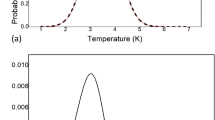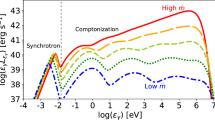Abstract
IT is widely believed that the microwave background radiation1–10 discovered by Penzias and Wilson had its origin in a hot, early phase of the expanding Universe. The possibility has recently been considered11,12, however, that it is instead a result of the thermalization of starlight by interstellar dust grains. It is claimed that this could explain the fact that the energy density of the 3° K radiation is very close to those of starlight, magnetic fields, turbulent gas motions and cosmic rays, all measured in the galactic disk, and also of the energy produced13 by the conversion from hydrogen to helium of one-third the mean density of visible galaxies—a fraction which corresponds to the ratio of helium to hydrogen in young stars14. A paper by Zeldovič and Novikov15 has already, in fact, considered and discounted this possibility, and the purpose of this communication is to draw attention to some difficulties particularly associated with the suggestions of Hoyle and Wickramasinghe11 and of Narlikar and Wickramasinghe12.
This is a preview of subscription content, access via your institution
Access options
Subscribe to this journal
Receive 51 print issues and online access
$199.00 per year
only $3.90 per issue
Buy this article
- Purchase on Springer Link
- Instant access to full article PDF
Prices may be subject to local taxes which are calculated during checkout
Similar content being viewed by others
References
Penzias, A. A., and Wilson, R. W., Astrophys. J., 142, 419 (1965).
Roll, P. G., and Wilkinson, D. T., Phys. Rev. Lett., 16, 405 (1966).
Howell, T. F., and Shakeshaft, J. R., Nature, 210, 1318 (1966).
Penzias, A. A., and Wilson, R. W., Astro. J., NY, 72, 315 (1967).
Welch, W. J., Keachie, S., Thornton, D. D., and Wrixon, G., Phys. Rev. Lett., 18, 1068 (1967).
Wilkinson, D. T., Phys. Rev. Lett., 19, 1195 (1967).
Stokes, R. A., Partridge, R. B., and Wilkinson, D. T., Phys. Rev. Lett., 19, 1199 (1967).
Ewing, M. S., Burke, B. F., and Staelin, D. H., Phys. Rev. Lett., 19, 1251 (1967).
Howell, T. F., and Shakeshaft, J. R., Nature, 216, 753 (1967).
Salomonovich, A. E., Stankevich, K. S., and Puzhano, V., reported at I.A.U. Thirteenth Gen. Ass., Prague (1967) (Astro. Zhurn., USSR, in the press).
Hoyle, F., and Wickramasinghe, N. C., Nature, 214, 969 (1967).
Narlikar, J. V., and Wickramasinghe, N. C., Nature, 216, 43 (1967).
Wagoner, R. V., Fowler, W. A., and Hoyle, F., Astrophys. J., 148, 3 (1967). See pp. 23–24.
Tayler, R. J., Quart. J. Roy. Astro. Soc., 8, 313 (1967).
Zeldovič, Ya. B., and Novikov, I. D., Astro. Zhurn., USSR, 44, 663 (1967).
Wickramasinghe, N. C., in Interstellar Grains (Chapman and Hall, Ltd., London, 1967).
Sievers, A. J., Phys. Rev. Lett., 13, 310 (1964).
Sievers, A. J., and Takeno, S., Phys. Rev., A, 140, 1030 (1965).
Partridge, R. B., and Wilkinson, D. T., Phys. Rev. Lett., 18, 557 (1967).
Davidson, W., and Narlikar, J. V., Rep. Prog. Phys., 29, part 2, 539 (1966). See p. 587.
Penzias, A. A., and Wilson, R. W., Astrophys. J., 146, 666 (1966).
Hoffmann, W. F., Woolf, N. J., Frederick, C. L., and Low, F. J., Science, 157, 187 (1967).
Verma, S. B., Phys. Rev. Lett., 18, 253 (1967).
Primak, W., and Fuchs, L. H., Phys. Rev., 95, 22 (1954).
Field, G. B., and Hitchcock, J. L., Astrophys. J., 146, 1 (1966).
Thaddeus, P., reported at Third Texas Symp. Relativistic Astrophys., New York (1967).
Author information
Authors and Affiliations
Rights and permissions
About this article
Cite this article
SHAKESHAFT, J., WEBSTER, A. Microwave Background in a Steady State Universe. Nature 217, 339–340 (1968). https://doi.org/10.1038/217339a0
Received:
Issue Date:
DOI: https://doi.org/10.1038/217339a0
This article is cited by
-
Measurement of ocean temperature and salinity via microwave radiometry
Boundary-Layer Meteorology (1978)
-
Discrete source counts and the rotation of the local Universe in hierarchical cosmology
Astrophysics and Space Science (1975)
-
Theoretical Black-body Radiation Temperature 2.2 K
Nature Physical Science (1972)
-
Neuere Probleme der Kosmologie
Naturwissenschaften (1969)
-
Upper Limits on Universal Microwave Radiation below λ = 1.7 mm
Nature (1968)
Comments
By submitting a comment you agree to abide by our Terms and Community Guidelines. If you find something abusive or that does not comply with our terms or guidelines please flag it as inappropriate.



